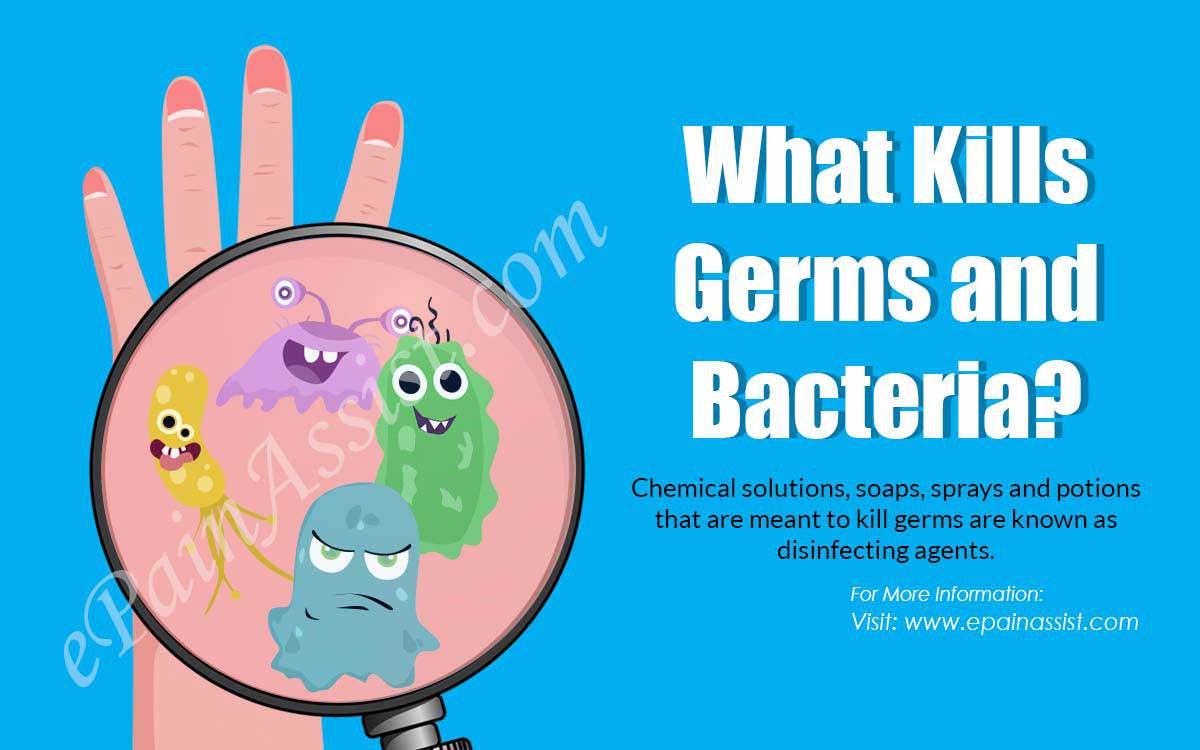Germs; in other words, viruses and bacteria are the main cause behind a host of diseases. These microscopic organisms can attack almost all parts of the human body often showing up as skin diseases or causing gastrointestinal problems. So, what kills germs and bacteria? If you are in search of an answer to this question, read on.

What Kills Germs and Bacteria?
Chemical solutions, soaps, sprays and potions that are meant to kill germs are known as disinfecting agents. They have found widespread favor because of their ability to eliminate disease causing germs. Such disinfecting agents are the ones that kills germs and bacteria. Read further to find an answer to what kills germs and bacteria?
Some of the most popular disinfectants that have the potential to kill germs and bacteria are given here.
Bleach
Bleach is by far the most effective germicide or disinfectant and is used in many forms to cleanse and sanitize. Bleach kills germs and bacteria and can protect you against many illnesses. However, bleach may be present in the cleaning solution you use to get stains off your clothes, cleaning solutions for toilets and floor cleaning solutions.
While bleach is very effective it can also be harmful when ingested in small quantities over a period of time which is why widespread bleach usage in the home environment and around kids and pets is unadvisable. There are multiple greener bleach alternatives that one can pick up at a department store however these alternatives aren’t generally as effective as bleach. It is important to note that both bleach and its greener variations are primarily intended for disinfecting in-house surfaces and are not to be used on skin.
Disinfecting Soaps
Disinfecting soaps that claim to kill germs and bacteria, claim that they can protect you against diseases. While such soaps are popular, these soaps have different components both natural and chemical. However, these soaps may not completely eliminate germs on your skin surface though specific products do an impressive job of sanitizing your body. The case for using these disinfecting soap is up for debate as some doctors claim that excess sanitizing and disinfecting weakens the immune system against bacteria and may even decrease the potency of antibiotics. The triclosan component of disinfecting soaps is a well-known endocrine disrupter and these soaps are largely unable to protect us against common diseases like colds and flu and only sanitize the surface of the skin.
Hand Sanitizers
When asked as to what kills germs and bacteria, one thing that surely comes to your mind are the hand sanitizers. Hand sanitizers are also popular disinfecting products with their sanitizing effects largely limited to the hands. Most people take advantage of these sanitizers as instant disinfectants for their hands to avoid spreading germs to other parts of their body or ingesting germs unknowingly. It is claimed that hand sanitizers kill germs and bacteria, although it may not be supported well. As most hand sanitizers are alcohol based; they do have some disinfecting action however the extent of it is largely unknown. Many hand sanitizers also contain triclosan.
Anti-Bacterial First Aid Products
For any injury or wound, the first aid products are popularly used as they kills germs and bacteria. An effective antibacterial first aid solution is often used to clean out the wound. This is largely sound advice; as this kills germs and bacteria that can lead to an infected wound. Anti-bacterial first aid solutions are must haves in every home and is the first step to curing a wound; even before application of topical ointments, stitches or bandaging.
Anti-Bacterial Mouthwash
The anti-bacterial mouthwash is a widely used product as it kills germs and bacteria. Most people consider these mouthwashes essential hygiene products and always have them in their bathroom cabinets.
Anti-Bacterial Facial Cleansers
Many products like facial cleansers claim that they kill germs and bacteria. These cleansers claim to have a germicidal and antibacterial action that can prevent the facial skin from breaking out in pimples or rashes caused by bacteria and germs. These products are quite popular and there is some anecdotal evidence to support their effectiveness.
Hydrogen Peroxide
When it comes to indoor cleaning, what kills germs and bacteria, is Hydrogen peroxide. It has germ eliminating properties which is why it is used in many indoor cleaning products. Hydrogen peroxide is largely safe for use when used at concentrate levels of 3% and it is highly biodegradable.
Vinegar
There is much anecdotal evidence to support the claim that vinegar has antibacterial and germ fighting properties; this is why vinegar finds favor as a holistic home cleaning product and is used to clean surfaces that are generally not cleaned with hydrogen peroxide or bleach cleaning solutions. Primary examples are kitchen counters, cooking ovens and table tops, as it kills germs and bacteria and can keep your surface clean.
Baking Soda
Baking soda is often used as a home remedy as it is believed that it kills germs and bacteria. Some evidence does support the effectiveness of baking soda to a fair degree but can be decided best by the user.
Tea Tree Oil
Tea Tree oil has antiseptic properties that can be used to disinfect wounds and cuts but its benefits do not extend beyond that. It is often considered a natural holistic remedy and finds its way into many first aid kits, as it kills germs and bacteria to some extent.
In conclusion; it is important to note that all of the disinfectants and germicides mentioned above have a fair degree of germ eliminating properties. Hence, they provide a solution to the question of what kills germs and bacteria. However, when dealing with a real bacterial or germ borne disease; it is best to consult a doctor. Germicidal products to clean homes should be used sparingly with kids and pets around and one must always read the label for warnings and precautions to be taken.
Also Read:
